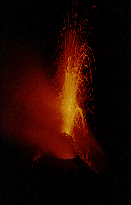| Stromboli
index |
||
| Geography | Geological Evolution | Eruptive history |
| Volcanic Hazards | References | Web sites |
Stromboli erupting from several vents, June 1992. Photo by Marco Fulle
Stromboli Volcano, Italy
volcano number: 0101-04= (according to Volcanoes of the World, 1994 edition)
summit elevation: 924 m (or 926 m)
location: 38.789°N, 15.213°E
![]()
 Typical Strombolian explosion: ejection of incandescent bombs and scoriae in discrete bursts. This photo was taken during the early morning of 22 August 1994, during a period of intense activity at Stromboli. |
|
|
|
Most of this activity is of a very moderate size, consisting of brief and small bursts of glowing lava fragments to heights of rarely more than 150 m above the vents. Occasionally, there are periods of stronger, more continuous activity, with fountaining lasting several hours, violent ejection of blocks and large bombs, and, still more rarely, lava outflow. Twice during the 20th century (in 1919 and 1930) there have been large eruptions that caused significant damage and killed persons even at considerable distance from the craters. Several explosions in the past few years have surprised groups of tourists who were in the summit area, causing various accidents as people began to run around in fear and consternation. Unfortunately, one person was killed by such an event in late 2001. Pure luck has prevented that tourists were in areas at risk when the volcano entered into a serious eruptive crisis at the end of 2002, and when a very powerful explosion occurred on 5 April 2003.
Although it has been visited almost daily by numerous people in the past thirty years or so, documentation of the activity of Stromboli has been far from complete until very recently. Thus, as recently as August 1994, the emission of a small volume of lava from the northernmost of Stromboli's presently three craters was only revealed several months later. The volcano is now being monitored visually by an automatic telecamera maintained by the Catania section of the Istituto Nazionale di Geofisica e Vulcanologia (INGV) whose task is the surveillance of seismic and volcanic activity in Sicily. Seismic stations are maintained by the monitoring network of the INGV and several other institutes such as the Dipartimento di Georisorse e Territorio of the University of Udine. These stations are continuously transmitting data to those institutes. However, as surprisingly as this might seem, much of the eruptive dynamics of Stromboli are still not fully understood, and there is a pressing need to further research on the way this volcano works.
These Stromboli pages will give some general information about the volcano and deal with some specific aspects of its recent eruptive history. Particular attention is devoted to the period since 1985 which includes many personal experiences by myself, and which has proved to be the best documented period in the history of Stromboli. As you will note these pages are densely interwoven with those of the companion site "Stromboli On-line", as both "Stromboli On-line" and "Italy's Volcanoes" are intended to complement each other.
A guide to the Stromboli pages
The first part of the Stromboli section introduces you to the geographical setting of the volcano, with information on the location and morphology of the island. From there you may proceed to the geological evolution of the volcano, which is anything else than simple. The eruptive activity during the historical period is reviewed on a number of pages, starting with a simple list of the major eruptive events known during that period, and then showing a series of photos taken on the volcano before 1930, a critical year during the recent history of the volcano. The powerful and destructive eruption of 1930 is described in detail, followed by an overview of the activity between 1930 and 1985. The ten years from 1985 to 1995 are then dealt with in much detail, including eyewitness accounts from myself and many others, numerous photos, and an analysis of the morphological changes caused by the eruptive activity. Activity after 1995 is described in a more synthetic manner on another page.
The final part of the Stromboli section talks about volcanic hazards, an aspect of studies on the volcano which is receiving increasing attention due to the growing number of visitors to the island, and following studies on violent eruptions in the not-too-distant past. This also includes a discussion of the way tourism is handled at the volcano in the light of numerous episodes of strong explosive activity in the past few years. The interested visitor will finally be guided to further reading and a selection of web sites about Stromboli.
Extensive cross-links to Stromboli On-line are provided throughout these pages. To return to these pages, use the "Back" button of your web browser.
Acknowledgments
Many photos shown on the Stromboli pages have been supplied in the early
days of this web site by Marco Fulle, whose suggestive images render
both an idea of the processes and locations and an artistic feel not
easily found in scientific photography.
Copyright © Boris Behncke, "Italy's Volcanoes: The Cradle of Volcanology"
